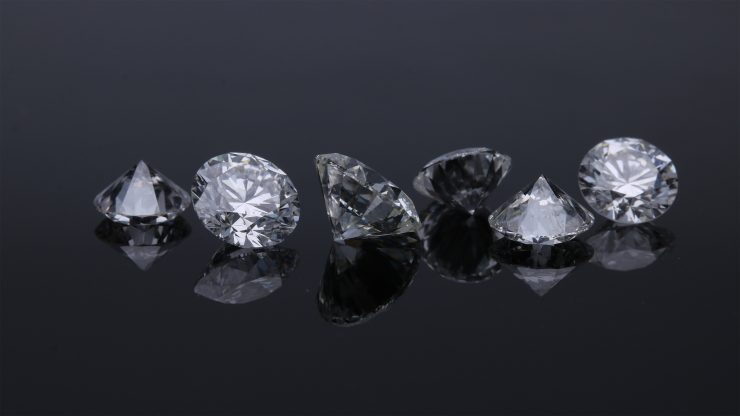Introduction: The Rise of Lab-Grown Diamonds in a Changing World
As global awareness surrounding climate change, sustainability, and ethical sourcing continues to grow, consumers are increasingly scrutinizing the origins of the products they purchase. This trend is particularly evident in the jewelry industry, where traditional mined diamonds have faced mounting criticism for their environmental degradation and human rights concerns. Lab-grown diamonds—created through technological processes rather than extracted from the earth—are emerging as a popular alternative among environmentally and socially conscious consumers. These diamonds, also known as synthetic or cultured diamonds, are chemically and physically identical to their mined counterparts but differ significantly in terms of environmental and ethical implications. Understanding the full spectrum of their ecological footprint requires a nuanced examination of their production processes, energy consumption, carbon emissions, and supply chain transparency. This article delves into these key areas, offering a detailed and objective look at the sustainability and ethical considerations associated with lab-grown diamonds.

Mining vs. Manufacturing: A Comparative Environmental Analysis
One of the most prominent arguments in favor of lab-grown diamonds is the stark environmental toll exacted by traditional diamond mining. Open-pit and alluvial mining methods, used extensively in diamond extraction, lead to the displacement of massive volumes of earth and significant deforestation. The process also contaminates water sources with heavy metals and chemicals, while contributing to soil erosion and habitat destruction for native wildlife. By contrast, lab-grown diamonds are developed in controlled laboratory environments using High Pressure High Temperature (HPHT) or Chemical Vapor Deposition (CVD) technologies. These methods bypass the need to disturb ecosystems or displace communities. Nevertheless, lab diamond production is not without its own environmental costs. The machinery required for HPHT and CVD processes demands substantial amounts of electricity, much of which is still generated through fossil fuels, depending on geographic location. Therefore, while lab diamonds present a substantially reduced ecological footprint in terms of land use and biodiversity impact, they still contribute to carbon emissions unless renewable energy sources are employed.
Energy Consumption: The Role of Power Sources in Sustainability
The sustainability of lab-grown diamonds is heavily influenced by the type of energy used in their production. CVD and HPHT technologies rely on high temperatures and pressure levels that require constant and intensive electricity. According to studies, some lab diamond manufacturers consume between 20 and 28 kilowatt-hours of electricity per carat produced—comparable to powering a household for several days. If the electricity is sourced from coal-powered plants, the carbon emissions may offset some of the perceived environmental benefits. Conversely, companies that invest in renewable energy, such as wind, solar, or hydroelectric power, can significantly reduce the environmental impact of their operations. A handful of industry leaders have begun to certify their diamonds as “climate-neutral” or “zero-emission” by integrating clean energy solutions into their manufacturing facilities. This growing shift underscores the importance of transparency and third-party verification, as consumers increasingly demand not only lab-grown diamonds, but sustainably grown diamonds. Therefore, the environmental benefits of lab-grown diamonds are most fully realized when they are produced using low-carbon or carbon-neutral energy infrastructure.
Carbon Footprint: Quantifying Emissions in Diamond Production
Determining the carbon footprint of a diamond, whether mined or lab-grown, involves analyzing all stages of its lifecycle—from resource extraction or manufacturing, to transportation and retail. Mined diamonds often have a substantially higher carbon footprint due to the emissions from diesel-powered mining equipment, the energy-intensive processing and sorting stages, and global shipping routes that transport stones from mines (often in Africa or Russia) to cutting centers and retailers worldwide. Lab-grown diamonds, produced closer to end markets and with fewer intermediary steps, can drastically cut down on transportation emissions. However, the overall carbon output still depends largely on how the laboratories are powered. According to a 2019 report by Frost & Sullivan, lab-grown diamonds can produce up to 63% fewer carbon emissions than mined diamonds, though these figures vary significantly by producer and energy source. For consumers seeking a lower carbon footprint, opting for lab diamonds certified by organizations that audit emissions data and environmental practices is a reliable way to make more informed choices.
Water Usage and Waste: Comparing the Hidden Environmental Costs
Water is another critical yet often overlooked factor in evaluating the environmental impact of diamonds. Traditional diamond mining can consume hundreds of gallons of water per carat and pollute nearby rivers and streams with sediment and waste byproducts, including mercury and other toxins. This pollution not only disrupts aquatic ecosystems but also jeopardizes water security for nearby communities. Lab-grown diamonds, in contrast, require much less water—some studies estimate that the production of one carat uses only 18 gallons, compared to over 125 gallons for a mined diamond. Additionally, because laboratory processes are contained in closed systems, wastewater can be treated and recycled more effectively, limiting contamination. Waste disposal is also more manageable in a lab setting, where materials can be filtered and reused rather than dumped into the environment. Still, the sourcing of input materials like graphite and gases used in CVD chambers can involve extractive industries with their own environmental implications. This highlights the importance of examining the full supply chain when considering the sustainability of lab-grown diamonds.
Ethical Labor Practices and Human Rights Considerations
One of the most compelling ethical arguments for lab-grown diamonds lies in the area of labor rights and human welfare. The natural diamond industry, particularly in historically conflict-prone regions such as Sierra Leone, the Democratic Republic of Congo, and Angola, has long been associated with exploitative labor conditions, including child labor, dangerous working environments, and insufficient wages. These conditions are often exacerbated by weak regulatory frameworks and a lack of enforcement. Although the Kimberley Process Certification Scheme was introduced to eliminate conflict diamonds, it has faced criticism for its narrow definition of “conflict” and its inability to address broader human rights violations. In contrast, lab-grown diamonds are produced in industrial settings—primarily in countries such as the United States, Singapore, India, and China—where working conditions can be more easily monitored and regulated. While labor rights concerns may still exist in certain manufacturing hubs, especially where regulatory oversight is weak, the potential for direct human harm is generally far lower than in traditional mining. This makes lab-grown diamonds an increasingly appealing option for ethically conscious consumers who prioritize transparency and fair labor practices.

Supply Chain Transparency and Traceability
Transparency throughout the diamond supply chain has become a top priority for consumers who want to ensure their purchases do not support unethical or environmentally damaging practices. In the traditional diamond industry, supply chains are long and complex, often involving multiple intermediaries and making it difficult to track a stone’s journey from mine to market. Even with existing certification systems, tracing the origin of a mined diamond with complete certainty remains a challenge. Lab-grown diamonds, however, offer greater potential for traceability due to the controlled nature of their production. Each diamond can be cataloged from its point of creation in a laboratory, and some producers now offer blockchain-based documentation to provide end-to-end visibility. This level of transparency allows consumers to verify the source, energy usage, and labor conditions associated with each stone. Moreover, manufacturers that voluntarily disclose details about their facilities, carbon outputs, and sustainability goals are establishing a higher standard of accountability within the industry. Such advances in traceability help consumers align their purchases with their environmental and ethical values.
Waste Management and Resource Efficiency
Beyond energy and water usage, the broader issue of material efficiency and waste reduction also differentiates lab-grown diamonds from their mined counterparts. Diamond mining generates enormous quantities of solid waste, including discarded rock and soil, which must be relocated and managed. For every carat of diamond extracted, approximately 250 tons of earth may be displaced. This waste, in addition to creating large-scale ecological disruption, requires long-term management and rehabilitation efforts that are often neglected. In contrast, the waste generated during the lab-growth process is relatively minimal and primarily consists of industrial gases and minor equipment wear. Furthermore, many laboratory producers have begun to implement circular economy practices, such as recycling gases, reclaiming used materials, and repurposing equipment. This more efficient use of resources not only reduces environmental harm but also represents a scalable model for sustainable production. While no industrial process is completely free of environmental cost, lab-grown diamonds tend to achieve significantly higher material efficiency and lower waste-to-output ratios compared to mining.
Industry Standards and Certification Challenges
Although lab-grown diamonds offer numerous sustainability and ethical advantages, the absence of standardized global regulations presents a challenge for consumers trying to verify these claims. Currently, there is no universally accepted certification for the environmental performance of lab-grown diamonds, though some independent bodies such as SCS Global Services and Carbon Trust have started offering third-party sustainability audits. In addition, laboratory-grown diamonds can be certified for quality and authenticity by gemological institutions like the IGI (International Gemological Institute) and GIA (Gemological Institute of America), but these certifications focus on physical characteristics rather than environmental impact. As consumer interest in sustainability continues to rise, there is a growing need for industry-wide standards that include environmental metrics such as energy consumption, carbon footprint, and water usage. Without such frameworks, greenwashing remains a risk, as some companies may exaggerate their environmental credentials without independent verification. Greater collaboration between producers, certifying agencies, and consumer advocacy groups could help establish meaningful benchmarks for sustainability in the lab-grown diamond sector.
Conclusion: A Step Toward a More Responsible Future
Lab-grown diamonds represent a significant shift toward more sustainable and ethically sound practices within the jewelry industry. By reducing reliance on environmentally damaging mining operations, lowering water consumption, improving supply chain traceability, and offering more transparent labor conditions, these diamonds align well with the values of environmentally conscious and ethically minded consumers. However, their environmental superiority is not absolute and depends largely on the methods of production, particularly the source of electricity used in the manufacturing process. As the industry matures and moves toward renewable energy adoption and stricter certification standards, lab-grown diamonds have the potential to become a genuinely low-impact alternative to mined diamonds. For consumers seeking to minimize their ecological footprint while avoiding the ethical pitfalls historically associated with diamond mining, lab-grown diamonds offer a compelling option—provided they do their due diligence to verify sustainability claims. In this evolving landscape, transparency, regulation, and innovation will remain key to ensuring that lab-grown diamonds fulfill their promise as the ethical choice for the future.